Brian Solis's Blog
November 21, 2025
From Siloed Experiments to AI Operating System: Architecting the Next-Gen Enterprise Right Now
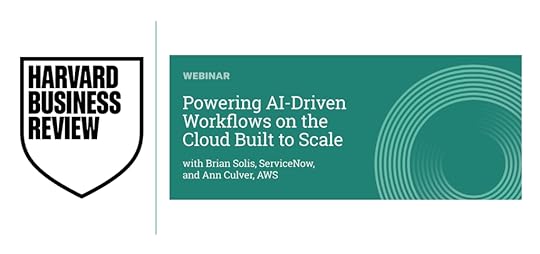
I recently had the opportunity (again!) to work with Ann Culver from Amazon Web Services (AWS) and Todd Pruzan at Harvard Business Review  on a special webinar and playbook. And they’re now available! (email gate). Links below!
on a special webinar and playbook. And they’re now available! (email gate). Links below! 
Why this is worth your time…
We dug into a tension we’re seeing in C-Suitesand boardrooms: Most organizations are still stuck in AI “pilot purgatory” and the box of “business as usual.” Companies have PoCs, scattered experiments, and a lot of hype, but not a scalable, enterprise-wide AI operating model.
Ann and I explored the shift from tools to transformation. AI-driven workflows are not about sprinkling models on top of yesterday’s processes. They are about orchestrating work differently end to end, powered by connected, trusted data, robust governance, and a culture that’s ready to operate at the speed of, well, not business as usual.
We also explored the shift from simple assistants to agentic AI: systems that can reason, collaborate, and make autonomous decisions across workflows.
Gartner projects that within 3 years, 15% of day-to-day work decisions will be made autonomously. This represents a new management reality, where leaders must design for humans and agents to work together across cloud, data, and workflow/cloud platforms.
 SPOILER ALERT: Companies are already repeating the worst mistakes of the digital transformation era. They are funding siloed AI initiatives, over-indexing on short-term potential, and under-investing in vision, culture, and scale. That’s why a recent ServiceNow study shows organizations’ AI maturity scores actually declined in the last year, dropping from 44 out of 100 to 35. Then there’s that viral MIT study…
SPOILER ALERT: Companies are already repeating the worst mistakes of the digital transformation era. They are funding siloed AI initiatives, over-indexing on short-term potential, and under-investing in vision, culture, and scale. That’s why a recent ServiceNow study shows organizations’ AI maturity scores actually declined in the last year, dropping from 44 out of 100 to 35. Then there’s that viral MIT study…
The message we wanted to land is this…
You don’t fix this with another pilot; you fix it by reimagining how your business works with AI at the center. Data + Workflows + AI.
When you unify distributed data, connect systems across end-to-end workflows (rewiring the enterprise), and run on cloud built to scale, you can lower costs by orders of magnitude, achieve 3x faster operational speeds, and save millions by optimizing processes with AI…all while improving customer response times, NPS, and lifetime value.
From there, then imagine the enterprise value you can unlock when you dream bigger! 

AI at scale starts at the top, not in the lab. Moving from pilots to production requires top-down leadership, a cohesive AI strategy, and a clear business case that links AI directly to revenue growth, cost reduction, and better risk outcomes. Experiments without executive ownership and an enterprise roadmap rarely scale.
We are entering the age of agentic AI, not just clever copilots. The evolution from basic AI assistants to multi-agent, reasoning systems means more and more daily decisions will be made autonomously. Leaders need to design workflows, governance, and operating models for humans and AI agents working together, not in parallel universes.
Silos are the silent killer of AI ROI. Many organizations are still making fragmented, department-level AI bets, as they did with early digital initiatives. Because AI needs connected data, people, and processes, siloed investments make it nearly impossible to show meaningful ROI or build an “AI-powered business,” not just pockets of automation.
Governance and innovation have to walk hand in hand. Over-rotating to compliance slows everything down; ignoring governance creates risk and backlash. The organizations that win are building centers of excellence, boards, or federated models that keep governance “front and center” while still leaving room to experiment, learn, and even fail quickly on the way to scale.
Start small, but design for big. High-impact, low-complexity use cases are the best entry point, but they should be chosen as part of a broader roadmap, not as isolated experiments. Each successful workflow becomes a proof point, a pattern, and a piece of the broader AI operating system you are building across the enterprise.
Empower people, don’t just upskill them. Training matters, but what really unlocks transformation is helping employees see how AI can change the nature of their work – shifting from repetitive tasks to higher-value creativity, curiosity, and problem solving. That means transparent communication, visible early wins, and AI champions in every business function to normalize AI as part of everyday work.
Cloud plus workflow is where scale actually happens. Together, ServiceNow and AWS provide an integrated platform for AI workflows: unifying data, hiding operational complexity, and enabling industry-specific agents that deliver intuitive, personalized experiences. With our “customer zero” approach, we test AI internally first so customers can move faster and with more confidence in their own environments
If you’re serious about moving beyond pilots and building an AI-driven enterprise that can truly scale, I encourage you to watch the full webinar, “Powering AI-Driven Workflows on the Cloud Built to Scale,” on HBR and download the accompanying webinar summary playbook to dive deeper into the frameworks, examples, and next steps we discussed.
Read Mindshift | Book Brian as a Speaker | Subscribe to a Quantum of Solis
The post From Siloed Experiments to AI Operating System: Architecting the Next-Gen Enterprise Right Now appeared first on Brian Solis.
November 20, 2025
What Would AI Do? A Simple Mindshift to Unlock Exponential Creativity (WWAID)

This week at ServiceNow, we hosted an internal AI Innovation event that left me incredibly energized about what’s next.
We kicked off with a powerful keynote from Jeremy Utley, author of Ideaflowand director of executive education at Stanford d.school. He shared how AI can amplify human creativity and unlock new ways of thinking.
We then spotlighted Amit Zavery, our President, CPO, and COO, who’s been leading our journey to becoming truly AI-native!
We also featured insights from Paul Hong, ServiceNow VP of Design and Swati Raju, VP of Engineering.
During a our conversation, Paul asked me:
“Brian, from your perspective, how does adopting an AI-native mindset expand what’s possible — for individuals, teams, or even entire product areas? Can you share an example where integrating AI sparked a new idea, accelerated a project, or revealed a possibility that didn’t exist before?”
Here’s how I’m thinking about it 
The mindset shift for me is stepping back and exploring what I didn’t know to know.
An AI-native mindset implies AI isn’t an add-on. It’s the core. If AI weren’t part of the equation, the solution wouldn’t (or couldn’t) exist.
That requires the acceptance of an uncomfortable truth: I am in the way.
My thinking, my approach, my assumptions and biases are inherently not AI-native.
The output on the other side of AI is just a reflection of the thinking and design that went into it. So to truly embrace an AI-native mindset, I have to stop starting with, “What would I do?” and instead ask:
WWAID…“What would AI do?”
When I start there, I’m forced to rethink my prompts, my constraints, and my expectations.
I shift from drawing on “known knowns” to intentionally designing for possibility.
That’s where innovation lives…in the creation of new value.
QuantumBlack, AI by McKinsey research shows that reimagining end-to-end workflows with AI is the #1 driver of EBIT impact. Not bolting-on AI, but rethinking the whole system.
Please watch the video for the rest of the story…
That’s the power of an AI-native mindset: treating AI not as a tool to speed up what we already do, but as a partner to help us discover what we couldn’t see before.
Please watch (and share) – Youtube! 
Read Mindshift | Book Brian as a Speaker | Subscribe to a Quantum of Solis
The post What Would AI Do? A Simple Mindshift to Unlock Exponential Creativity (WWAID) appeared first on Brian Solis.
November 15, 2025
Weaving a Web of Agents: ChatGPT Atlas Turns Search into Action and Discovery into Outcomes

I haven’t written about a browser since the early 2000s.
We are about to change how we discover, decide, and do things on the web again. And the very purpose of the web is shifting. For decades, the web was built for humans clicking links. The next era is being built for agents completing tasks. I’ll unpack that bigger shift in a follow-up, but first, let’s look at what’s here now and why it matters.
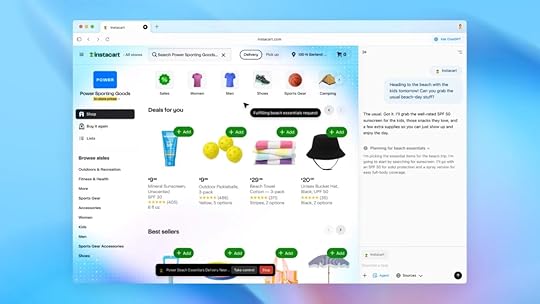
OpenAI’s ChatGPT Atlas and Perplexity’s Comet are not “browsers” in the classic sense. They introduce a new interaction model that collapses research and execution into a single flow.
Atlas puts ChatGPT inside the browser. You don’t type keywords and open tabs. You state the outcome you want and Atlas searches live, reasons across pages, and then acts. Research, shopping, travel, form fills, reservations. The result is less tab juggling and more finished work.Comet turns every page into an interactive surface. You can highlight anything, ask for counterpoints, follow tangents, and then act without losing context. It turns curiosity into momentum.
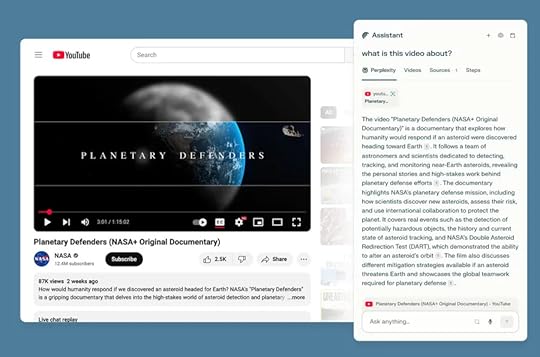
Both serve as personal assistants and agents.
The plot thickened when Microsoft shipped a nearly identical AI experience in Edge days after Atlas. That signals where platforms are going: agentic browsing becomes intentional.
This is the challenge and the opportunity. We’re moving from a web of browsing and transactions to a web of discovery, action, and outcomes.
The Shift from Keywords, Links, and Pages to Discovery, Decisions, and ActionsFor 20+ years the browser was a window. You typed a query, opened a dozen tabs, skimmed, copied, pasted, filled forms, and stitched the journey together yourself. The final mile was do-it-yourself.
In the agentic model, the browser becomes co-pilot and flight controller. You express intent, it gathers sources, weighs options, and executes. It returns a plan, a basket, a booking, or a brief. Fewer tabs. Faster decisions. More outcomes.
Atlas bakes ChatGPT into the browsing loop.Comet fuses Perplexity search with in-page reasoning.Edge’s new AI mode makes “do the task” a default pattern.This introduces a web that works for you.
Field notes: stress-testing Atlas in New YorkAhead of a trip to New York, I asked Atlas for the hottest restaurants, logged in where it suggested, set windows for lunch and dinner plus party size, and watched it research and attempt to book. When it couldn’t, it added me to waitlists and notifications. End-to-end tasking without a spreadsheet of tabs. I’ll post where I landed on IG.
Watch video here .
I’ve found reasons to use both Atlas and Comet, and I’m still learning the nuances. What’s clear: behavior shifts to intention to action to outcomes. People will expect planning, comparison, and checkout in one flow. Hands on the wheel, but less time on the road.
So what actually changes?1) Discovery compresses. We move from “find pages” to “produce outcomes.” Tasks, not queries, become the unit of value.
2) Trust becomes a ranking signal. Agents will privilege content with provenance, recency, and clear policies over thin pages and click-bait.
3) Design tilts toward machine readability. If your information can’t be parsed, reasoned over, and acted on by an agent, it risks being sidelined.
SEO isn’t Dead, but the SEO Playbook is…Classic SEO was written for crawlers and clicks. The next play is AEO: AI Experience Optimization. Design your content and commerce so agents can understand, trust, and transact. That’s where the web is going. Less a web for human consumption alone and more a web designed for LLMs and agentic processing.
What to do now
Make data callable. Expose inventory, pricing, availability, and policies through secure, well-documented APIs.Make knowledge machine-readable. Use structured schema, product graphs, sources, timestamps, authorship, and update cadence.Create action surfaces. Provide booking endpoints, carts, quotes, claims, and warranty flows so agents complete tasks, not just summarize pages.Publish agent briefs. Maintain concise, up-to-date fact sheets and constraints that LLMs can ingest and execute against.How companies win from hereShip APIs first. If an agent can’t call it, customers won’t complete it.Structure everything. Treat metadata like a product.Prove trust. Transparent sourcing, policies, and recency become the new PageRank.Measure outcomes, not visits. Track assistance rate, time-to-decision, completion, and repeat runs.Pilot an agentic journey. Pick one flow, whether it’s returns, warranty, claims, B2B quoting, and rebuild it for “state intent, decide, do, outcome.”What This Means for Business LeadersAgentic browsing is not a feature race, well…it’s a race toward shifting how you, and namely agents use the web. Essentially, it’s a shift in how value is created and captured online. When tasks and outcomes, not search and clicks, define success, the winners will be discovered and become part of the solution or outcome..
We’re moving from pages to progress. From browsing to doing. From ad-driven clicks to agent-driven completions.
It’s time to build for the agentic age and to learn when and how to let agents navigate and execute on your behalf.
Maybe now, we can finally close those tabs. We’ll see…I counted 30 open tabs as I finished this newsletter. 
Read Mindshift | Book Brian as a Speaker | Subscribe to a Quantum of Solis
The post Weaving a Web of Agents: ChatGPT Atlas Turns Search into Action and Discovery into Outcomes appeared first on Brian Solis.
November 14, 2025
Brian Solis to Keynote AI Summit: Agentic Singularity
Brian Solis will serve as the opening keynote for AI Summit: Agentic Singularity on December 9th. Registration is free.
We’re moving from “AI fluency and reskilling” to “Agentic operational transformation and business innovation,” a shift that demands more than new tools; it requires a total organizational mindshift.
Brian Solis, Head of Global Innovation at ServiceNow, argues that becoming truly AI-first means rebuilding the enterprise from the inside out…redefining leadership around imagination instead of efficiency, empowering mavericks who challenge “business as usual,” and recognizing that AI doesn’t replace people, leaders do. The future belongs to those who create new forms of value, not faster versions of the past, and who understand that optimism is not naive, but the operating system of authentic, innovative leadership.
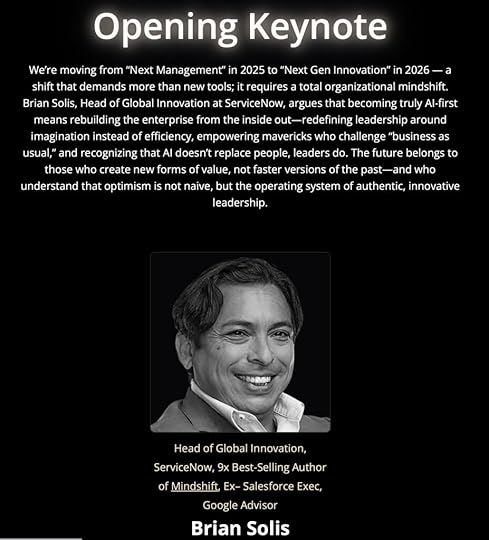
Screenshot
Screenshot
The post Brian Solis to Keynote AI Summit: Agentic Singularity appeared first on Brian Solis.
November 11, 2025
Brian Solis Named as a Top 50 Global Thought Leader in Sales by Thinkers 360
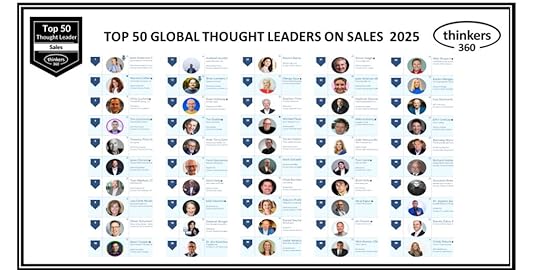
The Thinkers 360 listing includes members of Thinkers360 and who have curated and shared their thought leadership content from around the web – including articles, blogs, books, keynotes, media interviews, panels, podcasts, social media, speaking events, videos, webinars and whitepapers – via the platform to build their Thinkers360 profile, portfolio and media kit. Our differentiation from the various influencer leaderboards on social media, is that we take a holistic view of thought leaders, analysts and influencers, beyond their social media activity, and look across all the hats they may wear – such as academic, analyst, author, consultant, entrepreneur, influencer and speaker – and all the types of thought leadership content they produce.
AboutMore than just a list, Thinkers360TM live and annual leaderboards are differentiated by our unique patented algorithm that takes a holistic measure of thought leadership and authentic influence looking far beyond social media so brands can find exactly the right experts for their niche. Join us today! To find out more about how we calculate the rankings, please visit our article: Understanding the Thinkers360 Leaderboards.
The post appeared first on Brian Solis.
November 10, 2025
AI or Die: How 6% of AI High Performers are Rewiring Business Beyond the AI Status Quo
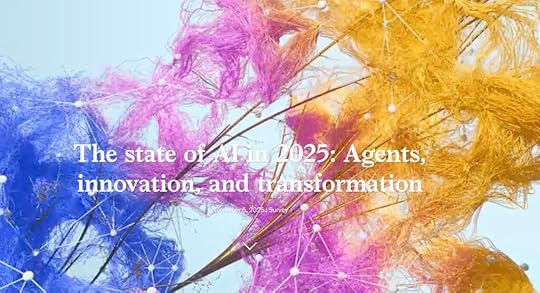
QuantumBlack AI by McKinsey released its new report, “The State of AI in 2025: Agents, Innovation, and Transformation.”
The data serves as a mirror, reflecting a world where AI is now everywhere, and yet, in most organizations, not nearly deep enough to transform them. Nearly all companies are “using AI,” many are flirting with agents, a tiny minority are breaking beyond the status quo, and an even smaller group is quietly exploring new horizons.
Below are the numbers that stood out to me.
Introduction: from experimentation to an AI divide
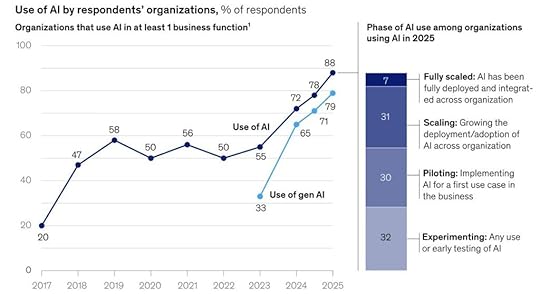
The headline is that 88% of companies now use AI in at least one function (up from 78%). But that was inevitable.
The story I’m paying attention to is the widening separation between:
organizations that treat AI as tools and pilots, andorganizations that treat AI as a new operating system for the business.McKinsey’s data confirms what many of us have been calling out in boardrooms: we’ve entered the agentic era, but most enterprises are still running legacy behaviors, patterns, and processes on next-generation technology. A small set of AI high performers (6%) are doing the opposite. They’re using AI, gen AI, and now agents to redesign workflows, re-architect value creation, and reimagine leadership itself. As result, they see EBIT impact of 5% or more.
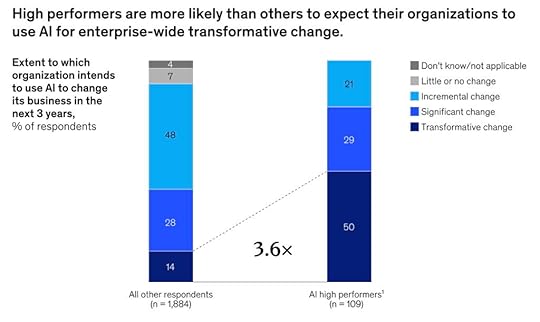
While the data tells a story of adoption, I’m looking at the companies writing a story about new identity and capacity.
What these stats are really saying (at a high level)…1. AI is now table stakes, but impact is optional88% using AI; 2/3 using it in multiple functions; ~1/2 in 3+ functions. This is ubiquity without guarantee of value. It tells us AI is no longer a differentiator by presence; it’s a differentiator by depth, design, and discipline.
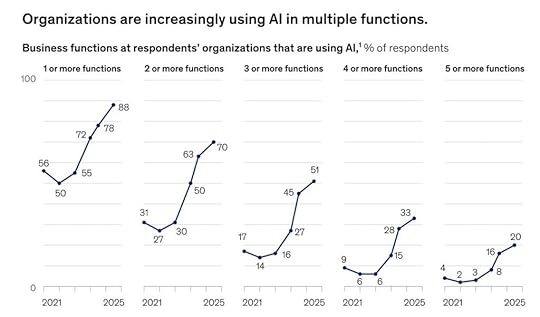
Yet only 39% tie any EBIT impact to AI, and most of that is <5%. Translation: most organizations have sprinkled AI on top of existing processes instead of rewiring how work gets done.
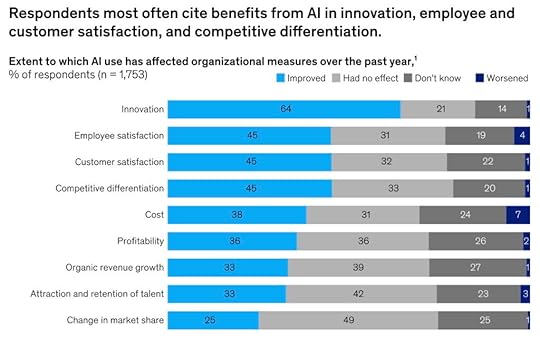
23% are scaling agentic AI in at least one function; another 39% are experimenting.
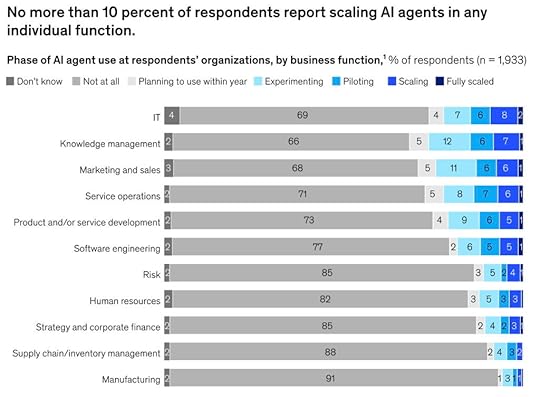
But in any function, only up to 10% say they are truly scaling agents, and usually in just 1–2 functions. Tech, media, telco, and healthcare lead.
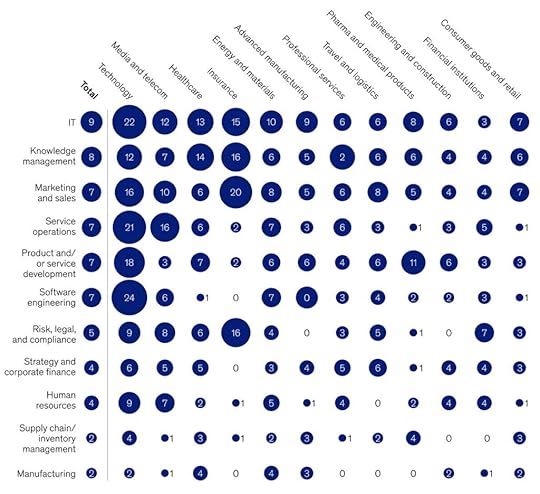
This signals a classic pattern: innovation at the edge, no unifying operating model. Agents are being deployed as bolt-on automation instead of end-to-end flow redesigns.
3. Scale is skewed to the big, and even they are earlyNearly half of companies with >$5B in revenue are in the “scaling” phase, versus 29% of those under $100M.

So far, scale favors the resourced. But that advantage is fragile. Smaller firms, if AI-native from the start, can move directly to agentic, automated, and adaptive models instead of dragging decades of technical and cultural debt.
4. The AI paradox: cost-out is easy; transformation is hardOrganizations are seeing point-level cost benefits, especially in software engineering, manufacturing, IT.
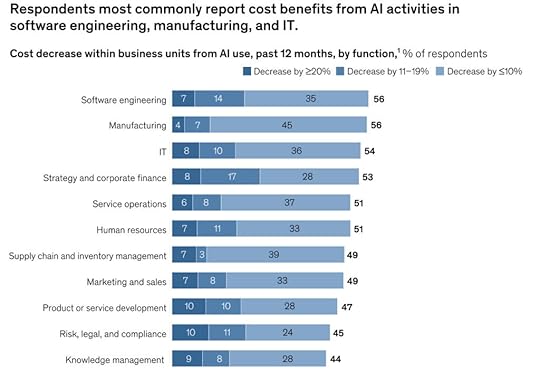
They report revenue and experience gains primarily in marketing & sales, strategy & corporate finance, and product development.
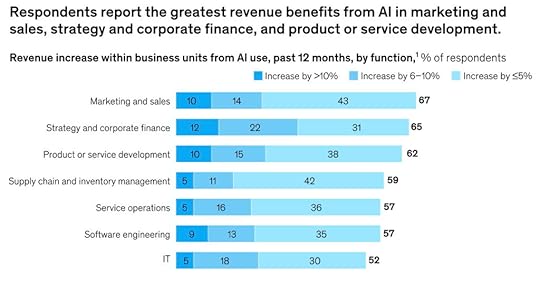
But enterprise-wide bottom-line change is “still rare.” That’s the paradox: lots of motion, little meaning. The companies stuck here think in terms of:
5. The 6%: what the AI high performers are actually doing“Where can we add AI?” Instead of: “Where can we reinvent value, experiences, and workflows with AI and agents at the core?”
That tiny cohort attributing 5%+ of EBIT to AI is the signal that matters.
Those “AI high performers” consistently:
Redesign workflows, not just tasks. These companies are ~3x more likely to say they’ve fundamentally rebuilt how work flows.

They deploy AI across more functions and are 3x more likely to scale agents across the business.

Treat leadership as the real platform: senior leaders sponsor, role model, and own AI initiatives. AI high performers’ use of AI is more often championed by their leaders. High performers are 3x more likely to strongly agree that senior leaders at their organizations demonstrate ownership of and commitment to their AI initiatives.

Run a full-stack playbook across 6 dimensions: 1) strategy, 2) talent, 3) operating model, 4) technology, 5) data, and 6) adoption and scaling. The most distinguished high performers employ a full set of management practices, based on more than 200 at-scale AI transformations.
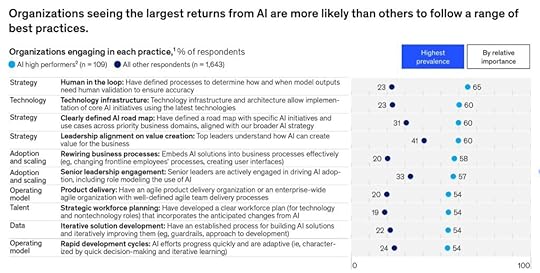
Invest like they mean it: 1/3 of high performers say they are investing >20% of digital budgets into AI; ~3/4 are scaling or have scaled.
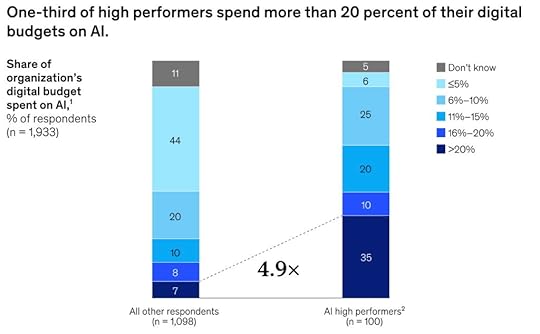
Simply said: they think bigger, move faster, and operate differently.
6. The mindset shift: beyond efficiency theaterOrganizations seeing the greatest impact from AI aim to achieve more than cost reductions. While most report that efficiency gains are an objective, high performers are more likely to also set growth and/or innovation as an objective of their AI efforts.
One of the clearest findings: Organizations that set growth + innovation (not just efficiency) as core AI objectives are more likely to see improvements in:
customer satisfactioncompetitive differentiationprofitability and revenue growtheven market share

This reinforces a central theme: efficiency is the floor, not the ceiling…meaning it’s not the bar for transformation. Treat AI only as a cost lever and you lock yourself into incrementalism while others build entirely new value chains.
From AI adoption to AI transformationIf you zoom out, this survey could also serve as a mirror that reflects outliers demonstrating curiosity, imagination, leadership, and courage.
Almost everyone has AI. Very few have the will to reimagine their company with it.
On one side we see “AI theater” where scattered pilots, siloed agents, slideware strategies, make no material impact.
On the other side, a small but growing set of agentic enterprises navigating new frontiers where they’re:
rewiring workflows,rebuilding their operating models,aligning culture, incentives, and leadership around a different future.
What if we dream bigger. Beyond asking, “How do we use AI to automate yesterday’s work and take out costs, we also ask, “If we started this company today, with AI, agents, and data at the core, how would we design it?”
That is the Mindshift.
This report should not reassure executives that they are “on track” because they have pilots in flight or agents in one function. It should unsettle them. It should make clear that the advantage is compounding in the hands of those 6% that are starting to break away from linear progression.
Assume that…
AI adoption is the next status quo.
Agentic AI is the next realm of exploration and possibility.
Re-architecting business, culture, and leadership becomes a force multiplier
This all sets the stage for cognitive Darwinism, companies that “think different” in how AI unlocks novel enterprise value.
AI or Die!
Read Mindshift | Book Brian as a Speaker | Subscribe
The post AI or Die: How 6% of AI High Performers are Rewiring Business Beyond the AI Status Quo appeared first on Brian Solis.
November 9, 2025
The Global Drucker Forum: Brian Solis on Mindshift, AI-Era Leadership, Value Creation, and the Power of Optimistic Innovation

Standing on the red carpet at the Global Peter Drucker Forum in Vienna with Franziska Graf, I was reminded why Peter Drucker’s ideas still matter…
In this short conversation at the historic Hofburg Palace, we explore:
1) The importance of a “Mindshift” right now, and how rethinking our mindset is the starting point for meaningful change.
2) How AI demands a next-generation model of leadership (hint: AI doesn’t decide who loses their job, leaders do).
3) Why the true role of the CEO, CIO, CHRO, and emerging Chief AI Officers is not to make tomorrow faster or cheaper or more scalable version of yesterday, but also to create new value that didn’t exist before.
4) Why optimism isn’t naive…a reminder that it’s a core pillar of innovation and authentic leadership.
Watch video on Youtube.
I’m grateful to Richard Straub, Julia Kirby, and the Drucker Forum community for creating a space where people genuinely committed to shaping the future of management (and leadership) come together to learn, challenge assumptions, and build what’s next.
And speaking of what’s next…we’re moving from “Next Management” in 2025 to “Next Gen Innovation” in 2026. The future of management depends on our ability to reimagine how we work, lead, and create value together.
| Keynote Speaker | Newsletter
The post The Global Drucker Forum: Brian Solis on Mindshift, AI-Era Leadership, Value Creation, and the Power of Optimistic Innovation appeared first on Brian Solis.
November 6, 2025
The Next Shift: From Workflows to Outcomes in the Agentic Age

Screenshot
When I sat down with Jaeden Schaefer on the AI Chat podcast, we didn’t talk about the latest AI trends, instead, we talked about a deeper inflection: moving from pilots that keep AI in a corner of the enterprise to agentic, end-to-end flows that actually do the work, learn from it, and elevate what people are free to do next.
Join host Jaeden Schafer as he welcomes Brian Solis, Head of Global Innovation at ServiceNow, to discuss the transformative power of AI in enterprise workflows. Discover how AI is reshaping industries, the importance of human orchestration, and the future of work in a rapidly evolving technological landscape.
Automation + augmentation (by design)I’m bullish on automation that removes the drudgery, especially when companies do something intentional with freed up time, space, and resources.. I’m also focused on augmentation, the intentional actions that give people AI superpowers with directives toward exponential outcomes.
The new human role: orchestrationAs agents take on work, a new job emerges: human orchestration. Think conductor, not operator. Design flows. Set guardrails. Monitor exceptions. Tune prompts and policies. Measure value per run, first-pass yield, and exceptions contained. And keep humans in, or above, the loop where judgment creates outsized value.
Browsers become co-pilots and auto-pilotsA small story with big implications: I asked Atlas to scout impossible-to-book NYC restaurants, navigate reservations, and track openings. Watching it reason and act across sites made one thing obvious: the browser is no longer a window, it’s a co-pilot and, with training, an auto-pilot for getting things done and eventually, getting them done autonomously.
These new browsers reconfigure discovery and decision-making for consumers and enterprises alike.
You can watch my Atlas test below the podcast video.
Mindshift: design from the outcome backStart with the outcome, quality, speed, cost, and risk, then design backward. Connect the full flow, give agents room to operate, and instrument learning so every run gets smarter. Most importantly, redeploy the time you free into deeper service, creativity, and relationships.
Performance gaps (and how to avoid them)There’s a growing delta between people who use AI to amplify their judgment and those who quietly offload their thinking. That gap becomes disruption, at the individual and enterprise level.
Your move: Pick an end-to-end flow.Stand up a control-tower view. Run with humans in and above the loop. Measure compounding value. And protect the one thing AI can’t replace: your originality.
This is your moment to change the trajectory of your role with AI.
Listen on Youtube, Spotify or Apple Podcasts.
Watch below 
| Keynote Speaker | Newsletter
The post The Next Shift: From Workflows to Outcomes in the Agentic Age appeared first on Brian Solis.
November 5, 2025
fastforward: Becoming an AI-first business requires a total organizational mindshift, an interview with Brian Solis
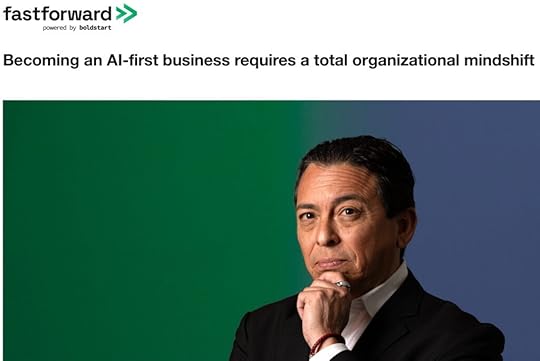
Ron Miller and Brian Solis explored what it means to be an AI-first company moving forward for fastforward, powered by boldstart…
Just about every organization wants to be an AI-first company right now, but making every part of the business run on AI is easier said than done. If history’s any guide, past digital transformation efforts showed how a lack of organizational buy-in can sink even the best intentions.
Brian Solis, head of global innovation at ServiceNow, and author of the book Mindshift, says his research found that one of the main reasons digital transformation projects didn’t pan out was looking at the process as an IT problem. That often led to digitizing certain parts of the business, which was fine as far as it went, but the impact rarely spread across the entire company.
“My counter to that research was to show what successful digital transformation looked like from a business standpoint. By analyzing the models of Amazon or Uber or Airbnb, I showed that if you put digital at the center of your business, this is what transformation could look like,” Solis told FastForward.
In his view, the key to any successful change is not confining it to a single group, but making it an end-to-end, enterprise-wide effort that actually alters the way you do business in a positive way. And the same principle applies to working toward becoming AI-first. You can’t look at it as a technology project. It requires a shift in organizational thinking that starts at the top and works its way through the entire company.
Making the shiftBox CEO Aaron Levie agrees that companies have to be thinking about what it means to be AI-first. “It’s really this idea that everything we do should be aided by AI and in the service of accelerating our work,” he said. If it works as described, that should result in faster, more intelligent decision making, while letting companies bring more products to market more quickly.
“The output of the organization should go up on a per-person basis, and we should be able to use AI to get that output to go up,” he said. And as that happens, he believes it will have a ripple effect across the company. It’s worth pointing out that few organizations to this point have achieved this level of change yet, but that is the goal, at least.
While Levie has articulated the vision, Solis looks at the frameworks to get there. He believes that you can’t reach Levie’s ideal by simply redesigning existing work processes. “AI cannot work in the box of business as usual. It really requires actual transformation, mostly from a data standpoint, which then involves breaking down silos and rethinking operational structures,” he said.
That means not only getting your data house in order, which is essential to successfully implementing AI projects, but also reimagining how your business could work in the age of AI. Solis says that requires a new kind of leader, one who could actually come from anywhere in the company, not just in the C-suite.
Finding the mavericksThe people who lead substantive organizational change like digital transformation or becoming AI-first may or may not be executives. They could be any employee who sees a better way to do things and leads by example, ignoring the noise and plowing forward, often bucking conventional wisdom. Solis calls these folks ‘change agents,’ anyone who is a “believer in and catalyst of progress; this is a person who sees a better future and is on the cusp of becoming a leader,” Solis wrote in Mindshift.
These are people who Jeff Bezos calls ‘mavericks,’ people who challenge the status quo. “[Successful companies] figure out how to support them and keep them driving change inside the company. Because really, most big companies get comfortable, and the mavericks cause discomfort, and so it’s easy to keep them away and kind of drive them out, but you’ll lose so much that way,” Bezos said recently at an Italian Tech Week interview.
AI cannot work in the box of business as usual.
Solis says most leaders lean on the familiar — their experience (the way it’s always been done), the board (the protectors of the known and routine) or the inner circle who probably won’t question the leader’s narrative. Fear of change leads to incremental programs instead of bold shifts, and it takes these special individuals to push through that.
Right now, we’re seeing a recurring problem with AI adoption where companies skip the hard work like prepping their internal data, while rushing into proof-of-concept projects, and finally falling back to status quo when results disappoint. “If it’s not showing true business impact, which is how we look at AI or any digital tool, as a cost-cutting tool for efficiency versus the unknown piece that could potentially unlock innovation, growth and business value,” he said.
In Mindshift, Solis not only defines the problems companies face, but also offers models for exploring meaningful change. “When you’re seeing answers or insights or you curate curious bits, you actually have a mechanism to expand it,” Solis explained.
All of this is to say, you can’t embrace big changes unless you see the possibilities a positive outcome could bring. “So that shift from self-awareness to ‘I don’t know what I don’t know,’ to imagination and curiosity, and then to building that framework — that’s the mind shift.”
| Keynote Speaker | Newsletter
The post fastforward: Becoming an AI-first business requires a total organizational mindshift, an interview with Brian Solis appeared first on Brian Solis.
November 3, 2025
AI Will Expose Leaders Who Think Like Machines: The Future Belongs to Architects of Possibility
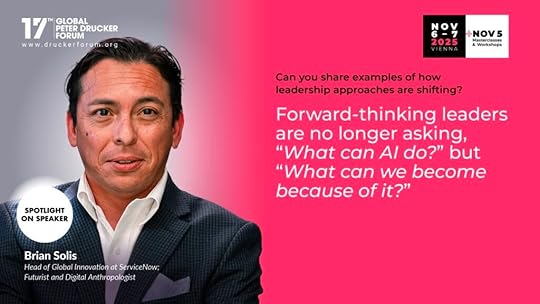
It’s been a dream to meet my idols, fellow peers, and also present at the Global Peter Drucker Forum. In 2024, Richard Straub and Julia Kirby made that dream a reality. And in 2024, we were just about two years into generative AI disruption that continues to disrupt enterprises and management thinking globally.
I’m proud, and more than ready, to return in 2025. And in the one short year it’s been since I’ve last joined this incredible group of academics, business leaders, my work at ServiceNow has focused on further documenting enterprise AI maturity, I published my first book in five years, Mindshift: Transform Leadership, Drive Innovation, and Reshape the Future, and I’ve launched several new initiatives that study how executives are, and should navigate AI business transformation.
In the lead-up to the 2025 Global Peter Drucker Forum, I spent time with the crew organizing the event. They worked with this year’s speakers to better understand how to help attendees and those they represent navigate the next year ahead. Here’s what I had to say, and I didn’t hold back…
Whether you’re attending the event, and I hope to see you if you are, or not, I’m sharing this unabridged interview with you so we can influence what happens next, together. 
We invite you to share your perspective on our annual topic, “Next Era Leadership: All Hands on Deck,” by reflecting on the following questions…
Q: Can you please share 5 sentences that describe your session:1. We stand at the threshold of a new leadership era, one where AI is exposing the limits of legacy thinking and legacy leadership, but the first stop for any “leader” is self-awareness…to ask themselves:
“Are we using AI to improve the past or invent the future?”
“Do we deploy AI to shrink our workforce, automate yesterday’s work, and chase quarterly gains or do we use AI to augment human potential, pursue exponential outcomes and gains, and invent entirely new sources of value?”
2. Peter Drucker said, “The greatest danger in times of turbulence is not the turbulence; it is to act with yesterday’s logic.” AI is that turbulence, and while many leaders respond with yesterday’s logic, the invitation to define the future is to lead with tomorrow’s logic. It starts with a mindset shit or a ‘mindshift.’
3. The future doesn’t need more managers to manage against yesterday’s processes, work, and standards; it needs architects of possibility who can lead in an age of intelligent machines and infinite potential. We need leaders willing to imagine, wonder, ask new questions and empower people around them to do the same.
4. AI doesn’t change businesses, leaders who dare to imagine business differently will use AI to change the business. It starts by rewriting the human algorithm of leadership itself, from management by control to leadership by curiosity, empathy, and empowerment. The true potential for next leadership is unleashed in how human creativity and machine intelligence can work in harmony to achieve what neither could alone.
5. In the next leadership era, success won’t come from scaling efficiency, but from scaling imagination… rethinking value creation, culture, and management itself through the lens of AI and augmentation.
Bonus: Drucker believes that the most valuable asset of a 21st century institution is its knowledge workers and their productivity. AI offers the ability to do more than automate repetitive tasks and improve productivity, to break free from static knowledge work…to imagine AI as a collaborator and a catalyst for enabling outcomes not possible before. If AI can do what you do, then what is it that you contribute? Knowledge now is about how fast you can learn, unlearn, imagine, and apply new creativity and understanding.
Q: How does your work help reshape management practices?I base a lot of my work, thinking, and experimentation on the disruptions happening in Silicon Valley by AI Native and AI First companies.
My work challenges leaders to see AI not as a technology to manage but as a catalyst to reimagine management itself. We start by embracing an “AI Forward Mindset.” This means means prioritizing the use of AI in exploring possibilities not achievable without it…and outcomes AI couldn’t achieve without you.
For too long, we’ve optimized for efficiency and productivity, not potential or the unknown. AI gives us the mirror to reflect on self-awareness, vision, and self-actualization. I outline what was, what is, and what could be with AI to redesign work, culture, and leadership around creativity, empathy, and adaptability….to iterate by automating yesterday and innovation by augmenting possibility and exploring new value creation.
In Mindshift, I write that transformation begins not with technology, but with mindset. Management must evolve from directing resources to developing new capacities, human and digital alike.
In Drucker’s terms, we must stop “doing things right” and start “doing the right things.” In an era when AI can perform much of yesterday’s work, we must imagine and do things differently.
For decades, management has been about optimizing for efficiency, doing things right, taking out costs, scaling capacity, increase speed. But in the age of intelligent machines, doing things right is the new status quo, just powered by AI. We must learn to do the right things differently.
Moving forward, it’s a balance of iterative AI and innovative AI.
Iterative AI strategies are purpose-built to solve real business challenges and improve everyday workflows. It removes the routine and complex, enabling faster, more efficient, productive, value-added work. Innovative AI investments aim to create entirely new products, services, or business models. It enables organizations to reimagine value creation by uncovering opportunities that were previously impossible or impractical, leading to exponential growth and competitive differentiation.
Q: What’s your ideal or utopian vision for the future of management?My utopian vision is one where management becomes one of human + AI orchestration and augmentation, not limited by administration and automation…a rebirth of human creativity and imagination co-powered with AI.
I would like to see a future where managers aren’t the bottlenecks of bureaucracy but the liberators of creativity.
Imagine leaders as designers of human-machine collaboration, embedding emotional intelligence into systems of artificial intelligence.
Organizations will evolve into “AInfinite Companies,” infinitely scalable, infinitely adaptable, infinitely human.
In this world, Drucker’s wisdom finds new form: management is no longer about controlling outcomes, but cultivating new possibilities.
Managers of the future will orchestrate intelligence, combining human creativity with machine precision to build companies that are infinitely adaptive.
In Drucker’s spirit, I’d say this: Management was once about getting people to follow. In the next era, it’s about empowering people, and machines, to co-create the future.
And those who lead with curiosity, those who dare to mix disciplines, ideas, and imagination, are the ones who will define what comes next.
Q: Can you share examples of how leadership approaches are shifting?Forward-thinking leaders are no longer asking, “What can AI do?” but “What can we become because of it?”
At companies I work with, we see “human + AI” teams forming new value networks, where digital employees handle precision, and humans handle perception.
CEOs are becoming “Chief AImagination Officers,” learning to experiment publicly, unlearn openly, and lead empathetically through uncertainty.
These are not tech transformations, they’re cultural awakenings. The leaders who thrive will not be those who manage change but those who visualize, articulate and inspire, and embody it.
Q: What quote or motto captures your management approach and the Forum’s “All Hands on Deck” spirit?“AI will expose managers who think like machines. You can’t manage your way toward reshaping the future. You can’t automate your way to innovation. The future doesn’t need more managers. It needs architects of possibility. The future of leadership is about mobilizing potential. In this age of intelligent machines, it’s all hands on deck, human and digital, to reimagine what leadership means and what humanity can become.”
Or, borrowing Drucker’s timeless pragmatism for an age of AI: “In times of AI, the most human leader wins.” 
Tickets are still available, use code “Social2025” for a special discount (RSVP HERE)
Mindshift | Keynote Speaker | Newsletter
The post AI Will Expose Leaders Who Think Like Machines: The Future Belongs to Architects of Possibility appeared first on Brian Solis.





